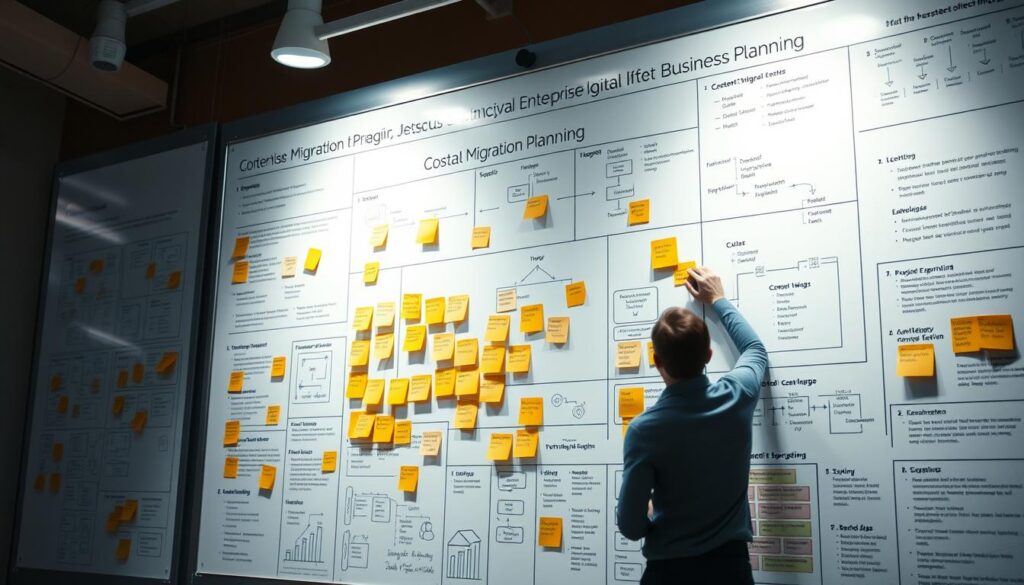Enterprise-level website migrations are a big deal. They can make or break a company’s online image. With so many URLs involved, these moves need careful planning and skill.
For businesses wanting to improve their digital setup, website migration services are key. They help keep search engine rankings high. But, the technical side can be tricky and might affect website traffic and SEO.
Getting through these digital changes right requires a detailed plan. It’s about keeping your brand’s online presence strong while moving forward with technology. A smooth migration means less risk and keeps your business running smoothly.
Key Takeaways
- Enterprise migrations involve managing hundreds of thousands of URLs
- Strategic redirect planning is crucial to prevent traffic loss
- migrations can take three to six months for full search engine recrawling
- Prioritize high-traffic pages during migration
- Continuous monitoring is essential for successful migration
- Professional website migration services can mitigate potential risks
Need help with a smooth enterprise-level website migration? Call Crowley Media Group at (916) 572-9755 or check out crowleymediagroup.com.
Understanding Enterprise Website Migration Fundamentals
Corporate website migration is a key strategy for companies looking to boost their online presence. These big moves need careful planning and skilled execution to avoid problems.
Understanding the basics of corporate website migration is crucial. It affects how a business runs and its online success.
Defining Migration Scope and Objectives
Good migrations start with clear goals. Companies must figure out what they need, like:
- Upgrading technology
- Boosting website speed
- Improving user experience
- Merging different online platforms
Key Challenges in Large-Scale Migrations
Big migrations face special hurdles that need smart solutions:
- Handling complex URLs
- Keeping search rankings
- Reducing website downtime
- Smoothly moving content
Impact on Business Continuity
A well-planned website migration can greatly help a business stay on track. About 70% of migrations face SEO issues, showing the need for detailed planning.
Important factors include keeping search rankings, protecting links, and avoiding disruptions during the switch.
Planning Your Enterprise-Level Website Migrations

For a successful enterprise site migration, careful planning is key. A detailed approach is needed to avoid risks and improve efficiency. Enterprises must create a strong migration plan that meets both technical and business needs.
Important steps for planning include:
- Conducting a thorough pre-migration site audit
- Mapping existing content and URL structures
- Identifying potential performance bottlenecks
- Establishing clear migration timelines
Website migrations can affect SEO performance. Studies show that poor planning can lead to a big drop in organic traffic. A detailed migration checklist is vital to avoid risks.
Key planning elements for a professional website transfer are:
- Content inventory assessment
- Backlink profile preservation
- Redirect strategy development
- Performance metric benchmarking
It’s important for enterprises to involve cross-functional teams in the migration. By working together with web development, design, and SEO experts, organizations can make the process smoother and avoid mistakes in their site migration solutions.
Technical Implementation Strategies
Website migration specialists know that moving a site to a new platform needs careful planning. They focus on making the transition smooth and efficient. This requires detailed technical knowledge and strategic thinking.
- Comprehensive redirect mapping
- Detailed content migration protocols
- Secure database transfer procedures
Redirect Mapping and Management
Managing redirects is key to keeping SEO performance high. Experts suggest using 301 permanent redirects for most URL changes. This careful planning helps avoid losing traffic and keeps search rankings intact.
- Conduct a complete URL inventory
- Create precise redirect mappings
- Verify redirect accuracy through thorough testing
Content Migration Protocols
Transferring content needs a structured approach to keep data safe and reduce disruption. Companies should create detailed plans to protect content and ensure a smooth move.
- Audit existing content repositories
- Validate content compatibility
- Implement staged migration strategies
Database Transfer Guidelines
Moving an enterprise database needs careful planning. Experts stress the importance of keeping data relationships intact, preserving history, and ensuring smooth functionality during the move.
By using these technical strategies, companies can make their website migration smooth and effective. This approach reduces risks and boosts performance.
Handling Large-Scale URL Redirects
Big website moves face special challenges with URL redirects. Many groups hit limits set by content management systems and online shops. Most CMS platforms only allow redirects for 50,000 to 100,000 URLs.
To tackle these issues, effective services use smart strategies. Here are some ways to manage lots of URL redirects:
- Using wildcard redirects for wide URL matches
- Focus on key pages with lots of visitors
- Creating special redirect solutions
- Applying advanced redirect mapping methods
In big website changes, 301 redirects are key. They keep most of the link value, making sure:
- Search rankings stay the same
- Page authority is kept
- Users have a smooth experience
- Traffic loss is avoided
Managing redirects well needs careful planning. Tools like Google Search Console and top SEO platforms help. They track redirect success, spot problems, and make sure big website moves go smoothly.
Performance Monitoring and Quality Assurance
After a corporate website migration, the next step is performance monitoring and quality assurance. This phase makes sure your website works well, is easy to find online, and offers a great user experience.
For a successful website migration, it’s important to track everything closely. Businesses need to watch their digital assets carefully during and after the move.
Traffic Analysis Tools
Using strong analytics platforms is key for tracking performance. Important tools include:
- Google Analytics 4 for detailed traffic insights
- Screaming Frog for technical SEO checks
- SEMrush for checking rankings and visibility
SEO Impact Assessment
Understanding how a website migration affects SEO is crucial. Important metrics to look at are:
- Changes in organic traffic
- Fluctuations in keyword rankings
- Indexation status
- Redirect success
User Experience Testing
User experience is vital during a website migration. Testing should check:
- Page load speeds
- Navigation ease
- Mobile responsiveness
- Conversion path integrity
Proactive monitoring turns migration challenges into chances for digital improvement.
Overcoming Common Migration Challenges

Transferring a website is a big challenge for companies going through digital changes. They need good plans to avoid risks and make the move smooth.
Dealing with data migration can be tough. Studies show what might go wrong:
- 70% of organizations face problems during migrations
- 50% of projects go over budget
- 30% lose or damage data during the move
To succeed, companies need to be ready. Important steps include:
- Comprehensive planning to spot and solve problems early
- Testing to keep data safe
- Doing the migration in steps to avoid big disruptions
Teams must focus on avoiding risks. With data growing to 200 zettabytes by 2025, careful planning is key. Good preparation can cut migration problems by 80%, keeping business running smoothly and saving money.
Companies that plan well for migration are set for success. They ensure a smooth change and keep things running smoothly.
Conclusion
Website migration needs careful planning. Working with skilled website migration specialists can make the process smooth. About 70% of migrations fail because of bad planning. Yet, 90% of those that succeed have detailed redirect plans.
Getting ready is crucial to avoid problems. Experts suggest setting up a staging site for testing before the move. They also advise documenting the site’s current structure well. Using server-side redirects and watching traffic can help avoid online issues.
For a smooth digital change, expert help is vital. Crowley Media Group offers full support for your website’s move. They help keep your site’s performance, SEO, and user experience top-notch. Contact them today to improve your migration plan and avoid common mistakes.
Are you ready for a successful website migration? Call Crowley Media Group at (916) 572-9755 or visit crowleymediagroup.com. Our team is ready to help you through every step of your digital journey.








